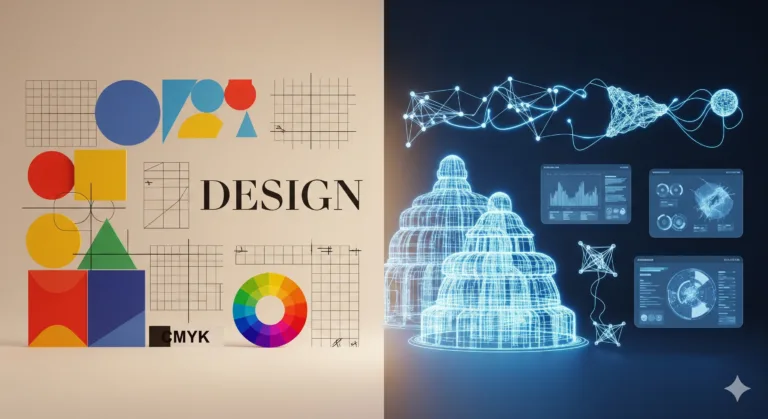Why Geometry in Design Matters?
Hey there, aspiring designer! Ever look at a logo, a website, or even a cool poster and feel something? Maybe it feels stable, dynamic, playful, or serious? A big part of that feeling comes from something super fundamental: shapes. They are the basic building blocks of everything visual, and understanding how to use them is like learning the alphabet of design.
Shapes aren’t just pretty forms; they carry meaning and can guide the viewer’s eye. They create structure and feeling. Mastering them means you can control the message your work sends, making it stronger and more effective. This guide will help you unlock the power of geometric forms to make your designs truly speak.
Table of Contents
What Exactly are Shapes in Design?
At its core, a shape is a two-dimensional area defined by lines or a boundary. Think of the simplest forms: circles, squares, and triangles. These geometric shapes are precise and mathematical, forming the foundation of countless designs.
You also have organic shapes, which are more freeform and natural, like blobs or curves found in nature. But today, we’re focusing on the power of geometry – the squares, circles, triangles, and the forms built from them. They are like the sturdy bones of your design structure.
Think of them as the essential building blocks. Just as letters combine to form words and sentences, basic geometric forms combine to create complex visuals and convey specific ideas or emotions without using a single word. They provide order and predictability, which the human eye often finds appealing and easy to process.
The Essential Pillars of Geometric Communication
- Meaning and Emotion: Different geometric forms evoke different feelings. Circles suggest unity and softness, squares imply stability and structure, while triangles convey dynamism and direction. Understanding these associations is key.
- Structure and Composition: Geometric patterns and arrangements create visual frameworks. Using shapes helps organize elements on a page or screen, guiding the viewer’s eye through the design in a logical flow.
- Visual Hierarchy: Varying the size, color, or placement of shapes can draw attention to specific areas. Larger or bolder forms naturally stand out, helping you emphasize important information or elements in your layout.
- Pattern and Repetition: Repeating or arranging shapes in a consistent manner creates rhythm and visual interest. Patterns can make a design feel harmonious and complete, adding depth and texture without clutter.
Mistakes That Can Ruin Your Shape Strategy
Even with simple elements like forms, it’s easy to stumble. Being aware of common pitfalls will save you a lot of headaches and help your designs look polished and intentional. Avoiding these missteps is crucial for effective visual communication using geometry.
- Overusing Too Many Different Forms
Problem description: Cramming too many distinct shapes into one design makes it look chaotic and confusing, losing its clear message.
Solution: Limit your palette to a few key geometric forms that work together and support your overall concept. Consistency is your friend. - Ignoring the Emotional Weight of Geometry
Problem description: Using shapes that clash with the intended mood or message, like sharp triangles for a calming brand.
Solution: Research the psychological associations of basic forms and choose those that align with the emotion or concept you want to communicate effectively. - Lack of Alignment and Spacing (Proximity)
Problem description: Placing shapes randomly without considering how they relate to each other, leading to a messy layout.
Solution: Use grids and guides to align forms precisely. Pay attention to the negative space around them; it’s just as important as the shapes themselves in creating balance and clarity.
Step by Step: Applying Shapes to Your Projects
Ready to put this into practice? Using geometric forms effectively is a process that involves planning and iteration. Here’s a simple approach to integrating geometric shapes into your next design project, building confidence as you go.
- Step 1 – Define Your Message/Feeling: What do you want your design to communicate? Is it about stability, energy, community, or something else? Your goal will inform your shape choices. For instance, a financial site might use rectangles for trustworthiness, while a children’s brand might favor circles for playfulness.
- Step 2 – Choose Your Core Forms: Based on your message, select one or two primary geometric shapes that resonate with that feeling. Decide if you’ll use squares, circles, triangles, or perhaps a combination. These will be the dominant players in your visual language.
- Step 3 – Combine and Arrange: Start placing and combining your chosen shapes. Experiment with different sizes, rotations, and overlaps. Think about how they interact and how they guide the viewer’s eye across the composition. Use repetition to create patterns or emphasize points.
- Step 4 – Refine and Simplify: Step back and look at your design. Is the message clear? Is it visually balanced? Remove any unnecessary shapes. Often, simpler arrangements of geometric forms are the most powerful and easiest for the viewer to understand and appreciate quickly.
Frequently Asked Questions about Shapes in Design
Using geometric forms can spark a few questions, especially when you’re starting out. Here are some common ones to help clear things up as you begin experimenting with this powerful design element.
Q: Can I mix geometric and organic shapes?
A: Absolutely! Combining them can create interesting contrast and visual tension, adding depth to your compositions.
Q: How do I know which shape is right for my brand?
A: Consider your brand’s personality and values; research the common associations of basic forms and see which aligns best.
Q: Do shapes affect readability of text?
A: Yes, shapes used as backgrounds or containers can impact how easy text is to read; ensure sufficient contrast and avoid overly busy patterns behind important information.
Conclusion: Shapes in Practice
You’ve now seen that shapes, particularly geometric shapes, are far more than just basic forms. They are essential tools for communication in design, capable of conveying emotion, building structure, and guiding attention. Understanding their fundamental power is a huge step forward in your design journey.
Start noticing the shapes around you in the designs you admire. Experiment with squares, circles, and triangles in your own projects. Play, combine, and see how they change the feel of your work. With practice, communicating through geometry will become second nature, opening up new possibilities in your creative expression.



